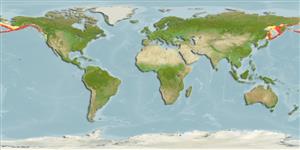Common names from other countries
>
Perciformes/Cottoidei (Sculpins) >
Agonidae (Poachers) > Hemitripterinae
Etymology: Hemitripterus: Greek, hemi = half + Greek, tres, tria = three + Greek, pteron = wing, fin (Ref. 45335); bolini: Named after R.L. Bolin, U.S. ichthyologist (Ref.6885)..
More on author: Myers.
Environment: milieu / climate zone / depth range / distribution range
Ecologia
marinhas demersal; intervalo de profundidade 25 - 925 m (Ref. 6793), usually 200 - 300 m (Ref. 57943). Temperate
North Pacific: Bering Sea to the Aleutian chain and Eureka, California, USA.
Tamanho / Peso / Idade
Maturity: Lm ? range ? - ? cm
Max length : 73.0 cm TL macho/indeterminado; (Ref. 48798); idade máx. registrada: 23 anos (Ref. 122394)
Espinhos dorsais (total): 13 - 14; Raios dorsais (total): 11-12; Espinhos anais 0; Raios anais : 13. Caudal fin rounded (Ref. 6885). Color mottled gray or brown above, paler below; four or five vague darker saddles across back; two tan stripes across head; red below anterior part of spinous dorsal; mottled red brown on membranes of spinous dorsal fin, lighter between fifth and eighth spines; chestnut brown on rayed dorsal with pale gray marbling; on pectorals alternating bands of yellow brown, light gray, and dark brown; light gray with fine black speckling and orange patches on anal fin; on caudal fin dark reddish brown with fine vertical stripes of gray brown (Ref. 6885).
Occurs offshore (Ref. 2850).
Ciclo de vida ou comportamento de acasalamento
Maturidade | Reprodução | Desova | Ovos | Fecundidade | Larvas
Eschmeyer, W.N., E.S. Herald and H. Hammann, 1983. A field guide to Pacific coast fishes of North America. Boston (MA, USA): Houghton Mifflin Company. xii+336 p. (Ref. 2850)
Status na Lista Vermelha da UICN (Ref. 130435)
CITES (Ref. 128078)
Not Evaluated
Ameaça para os humanos
Harmless
Uso pelos humanos
Peixe esportivo: sim
Mais informação
ReferênciasAquaculturaPerfil para aquaculturaEstirpesGenéticaElectrophoresesHereditariedadeDoençasProcessamentoConversão de massa
ColaboradoresFotosStamps, Coins Misc.SonsCiguateraVelocidadeTipo de nataçãoÁrea branquialOtólitosCérebrosVisão
Ferramentas
Relatórios especiais
Baixar XML
Fontes da internet
Estimates based on models
Preferred temperature (Ref.
115969): 0.7 - 5.5, mean 1.6 (based on 106 cells).
Índice de diversidade filogenética (Ref.
82804): PD
50 = 0.6289 [Uniqueness, from 0.5 = low to 2.0 = high].
Bayesian length-weight: a=0.01096 (0.00533 - 0.02257), b=3.06 (2.87 - 3.25), in cm Total Length, based on LWR estimates for this species & (Sub)family-body (Ref.
93245).
Nível Trófico (Ref.
69278): 4.5 ±0.8 se; based on diet studies.
Resiliência (Ref.
120179): Baixo, tempo mínimo de duplicação da população 4,5 - 14 anos (Preliminary K or Fecundity.).
Fishing Vulnerability (Ref.
59153): High vulnerability (59 of 100).
